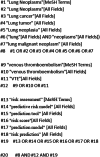A systematic review of risk prediction model of venous thromboembolism for patients with lung cancer
- PMID: 38233997
- PMCID: PMC10834197
- DOI: 10.1111/1759-7714.15219
A systematic review of risk prediction model of venous thromboembolism for patients with lung cancer
Abstract
Background: Venous thromboembolism (VTE) increases the risk of death or adverse outcomes in patients with lung cancer. Therefore, early identification and treatment of high-risk groups of VTE have been the research focus. In this systematic review, the risk assessment tools of VTE in patients with lung cancer were systematically analyzed and evaluated to provide a reference for VTE management.
Methods: Relevant studies were retrieved from major English databases (The Cochrane Library, Embase, Web of Science, PubMed, Scopus, Medline) and Chinese databases (China National Knowledge Infrastructure [CNKI] and WanFang Data) until July 2023 and extracted by two researchers. This systematic review was registered at PROSPERO (no. CRD42023409748).
Results: Finally, two prospective cohort studies and four retrospective cohort studies were included from 2019. There was a high risk of bias in all included studies according to the Prediction Model Risk of Bias Assessment tool (PROBAST). In the included studies, Cox and logistic regression were used to construct models. The area under the receiver operating characteristic curve (AUC) of the model ranged from 0.670 to 0.904, and the number of predictors ranged from 4 to 11. The D-dimer index was included in five studies, but significant differences existed in optimal cutoff values from 0.0005 mg/L to 2.06 mg/L. Then, three studies validated the model externally, two studies only validated the model internally, and only one study validated the model using a combination of internal and external validation.
Conclusion: VTE risk prediction models for patients with lung cancer have received attention for no more than 5 years. The included model shows a good predictive effect and may help identify the risk population of VTE at an early stage. In the future, it is necessary to improve data modeling and statistical analysis methods, develop predictive models with good performance and low risk of bias, and focus on external validation and recalibration of models.
Keywords: lung cancer; risk prediction model; systematic review; venous thromboembolism.
© 2024 The Authors. Thoracic Cancer published by John Wiley & Sons Australia, Ltd.
Conflict of interest statement
The authors declare that there is no competing interest.
Figures
Comment in
-
Navigating venous thromboembolism risks in lung cancer patients.Thorac Cancer. 2024 May;15(14):1195-1196. doi: 10.1111/1759-7714.15290. Epub 2024 Apr 3. Thorac Cancer. 2024. PMID: 38567710 Free PMC article. No abstract available.
Similar articles
-
Prediction of risk of recurrence of venous thromboembolism following treatment for a first unprovoked venous thromboembolism: systematic review, prognostic model and clinical decision rule, and economic evaluation.Health Technol Assess. 2016 Feb;20(12):i-xxxiii, 1-190. doi: 10.3310/hta20120. Health Technol Assess. 2016. PMID: 26879848 Free PMC article.
-
[Volume and health outcomes: evidence from systematic reviews and from evaluation of Italian hospital data].Epidemiol Prev. 2013 Mar-Jun;37(2-3 Suppl 2):1-100. Epidemiol Prev. 2013. PMID: 23851286 Italian.
-
Effect of testing for cancer on cancer- or venous thromboembolism (VTE)-related mortality and morbidity in people with unprovoked VTE.Cochrane Database Syst Rev. 2021 Oct 1;10(10):CD010837. doi: 10.1002/14651858.CD010837.pub5. Cochrane Database Syst Rev. 2021. PMID: 34597414 Free PMC article.
-
Comparison of Two Modern Survival Prediction Tools, SORG-MLA and METSSS, in Patients With Symptomatic Long-bone Metastases Who Underwent Local Treatment With Surgery Followed by Radiotherapy and With Radiotherapy Alone.Clin Orthop Relat Res. 2024 Dec 1;482(12):2193-2208. doi: 10.1097/CORR.0000000000003185. Epub 2024 Jul 23. Clin Orthop Relat Res. 2024. PMID: 39051924
-
Effect of testing for cancer on cancer- and venous thromboembolism (VTE)-related mortality and morbidity in people with unprovoked VTE.Cochrane Database Syst Rev. 2017 Aug 23;8(8):CD010837. doi: 10.1002/14651858.CD010837.pub3. Cochrane Database Syst Rev. 2017. Update in: Cochrane Database Syst Rev. 2018 Nov 08;11:CD010837. doi: 10.1002/14651858.CD010837.pub4. PMID: 28832905 Free PMC article. Updated.
Cited by
-
Development and validation of a risk prediction model for venous thromboembolism after surgery in elderly patients with lung cancer.BMC Surg. 2025 Aug 9;25(1):357. doi: 10.1186/s12893-025-03080-8. BMC Surg. 2025. PMID: 40783702 Free PMC article.
-
Navigating venous thromboembolism risks in lung cancer patients.Thorac Cancer. 2024 May;15(14):1195-1196. doi: 10.1111/1759-7714.15290. Epub 2024 Apr 3. Thorac Cancer. 2024. PMID: 38567710 Free PMC article. No abstract available.
References
Publication types
MeSH terms
Grants and funding
- 82241229/General Program of the NSFC general program of China
- 82272796/General Program of the NSFC general program of China
- KY201701/Aiyou Foundation
- 2022-I2M-1-009/CAMS Innovation Fund for Medical Sciences (CIFMS)
- CICAMS-MOTRP 2022002/Nursing Project of Medical Oncology Key Foundation of Cancer Hospital, Chinese Academy of Medical Sciences
LinkOut - more resources
Full Text Sources
Medical



